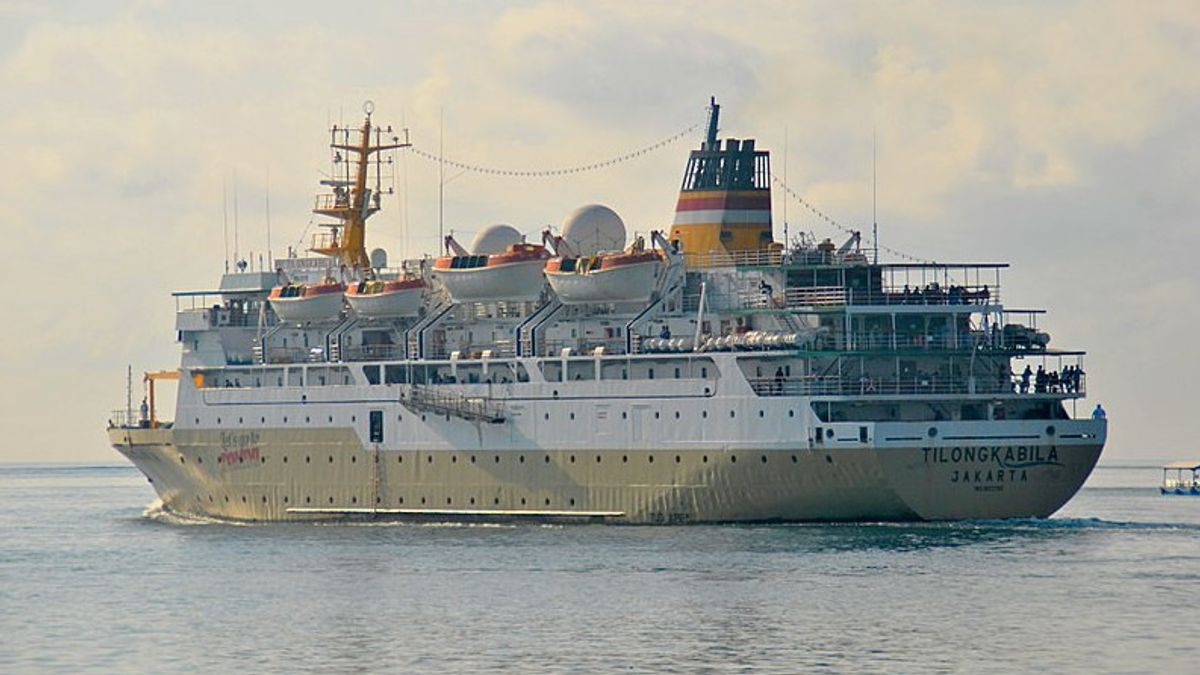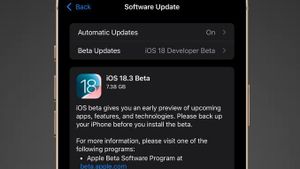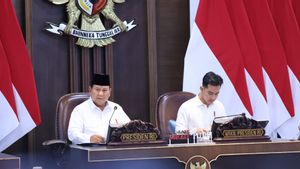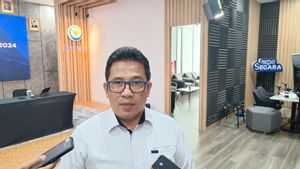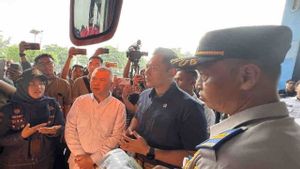JAKARTA - Sea transportation has a vital role in uniting Indonesia. Long ago, Mahapatih Gajah Mada had sworn to unite the archipelago. The oath is forever remembered as the Palapa Oath. Gajah Mada's courage was justified. Majapahit's naval fleet was so strong in its time.
However, Gajah Mada's dream was only fully realized when Indonesia became independent. PT. The Indonesian National Shipping (Pelni) took over the Dutch shipping airline Koninklijke Paketvaart Maatschappij (KPM) as the estuary. Even Pelni became the actual embodiment of the unification of the archipelago: from Sabang to Merauke.
Perhaps Gajah Mada is the most flashy figure after Hayam Wuruk in the history of the Majapahit kingdom. The presence of Majapahit, as stated by Soekarno, is proof that Indonesia has reached the center of the highest civilization. Traces of Majapahit power appeared throughout the country. Along with the influence of Hindu religious teachings.
There are no less than 98 kingdoms under the banner of the Majapahit kingdom. The hegemony of the Majapahit empire continues. The appointment of Gajah Mada as Patih Amangkubumi Majapahit was the most decisive episode. During his appointment ceremony, the Palapa Amukti Oath was held. The oath contained the pledge of a Gajah Mada who wanted to unite the archipelago in one command.
Gajah Mada's confidence was based on the ability of the navy to the Majapahit army which had the upper hand. "Even if the huwus lost to Nusantara, the Isun Amukti Palapa, but the Desert Ring, the Seran Ring, Tanjung Pura, Haru Ring, Pahang Ring, Dompo, Bali Ring, Sunda, Palembang, Tumasik, Samana Isun Amukti Palapa," said Gajah Mada.
The oath pronounced at Gajah Mada's inauguration as Mahapatih of Majapahit in front of Queen Tribhuana Wijayatunggadewi means: "If I have united the archipelago, I will (only) break my fast. If I defeat Gurun, Seram, Tanjung Pura, Pahang, Dompo, Bali, Sunda, Palembang , Tumasik, that's how I (just about to) break my fast."
The echo of the Palapa oath actually brought the winds of change. The early style of Majapahit as an agrarian kingdom, turned into a maritime kingdom. Because, Gajah Mada is not only a strategist, but also a true statesman.
Thanks to him, Majapahit reached the peak of glory that had never been imagined before in various fields. Included in the progress of literature. Empu Prapanca succeeded in compiling the Negarakertagama Book. Others, Master Tantular managed to catch up with the Book of Sutasoma and Arjuna wiwaha.
“With the Palapa Oath, Mahapatih Gajah Mada is determined to unite the archipelago. Admiral Nala was appointed Jaladimantri in charge of leading the sea power of the Majapahit Kingdom. Through a strong navy, the Majapahit kingdom was able to control the entire archipelago to the Malay Peninsula and the Philippines," wrote Admiral Tedjo Edhy Purdijatno in the book Guarding the Maritime State Border (2010).
The Netherlands takes powerThe wealth of the archipelago is truly second to none. Its abundant produce and various spices are very famous in the world, especially in Europe. This wealth then attracted the hearts of countries in Europe to come to the motherland. The initial narrative did trade, he said. However, there is also an intention to monopolize the spice trade routes in the archipelago. The Netherlands is the most insistent country to monopolize spices.
The decisive period of Dutch colonialism was during the Governor General of the VOC twice ---1619-1623 and 1627-1629—Jan Pieterszoon Coen served. Thanks to his well-known political program, Discourse on the State of the Indies, Coen, who was then the chief bookkeeper and director of trade in Banten, placed Jayakarta in an important position for the welfare of the Dutch. Young Coen, at the age of 28, immediately focused his opinion on the conquest of the Indies (Indonesia) on two arguments.
“Coen bases his opinion on two arguments. First, that trade with the East was necessary for the welfare of the Dutch Republic. And second, that the Dutch had a legal right to continue this trade and even monopolize trade in many places,” said Bernard HM Vlekke in the book Nusantara (1961).
The political program succeeded in convincing 17 directors of the Dutch VOC trading company, known as Heeren Zeventien. Moreover, Coen began studying the world of trade, even at the age of 13 years. Coen was the only person who drew the conclusion that the position of the Dutch in trading in the Indies was legally quite strong. Through his policies, Coen was revered as the founder of Dutch colonialism in the archipelago.
Gradually, the Company took control of Jayakarta and turned it into Batavia in 1619, then spread throughout Java, like a flame. The Dutch rule continued until the VOC trading company collapsed in 1879, and was replaced by the Dutch East Indies Colonial Government in 1880.
The existence of the Dutch was none other than the desire to gain profit in trade in the archipelago. At that time, controlling the maritime archipelago was the same as a shortcut to mastering world trade.
“Meanwhile, the expansion of the power network is increasing in the Indonesian archipelago. At the end of the 19th century the Dutch East Indies Colonial State almost succeeded in conquering all the kingdoms and political communities in the Indonesian archipelago. Great and fierce resistance was faced in a number of places, for example Aceh, Tapanuli, and Nusa Tenggara.”
“As for West Papua, the politics of the Dutch East Indies is still in the form of exploration and early exploration of colonialism. With this pacification, the network and relations between places in the Indonesian archipelago will be more open and more intensive. In addition, international trade networks continue to develop in the midst of new invaders, such as the United States, Germany, and then Japan,” concluded Abdullah Idi in the book Political Ethnicity of the Dutch East Indies (2019).
The emergence of KPM
The golden age of the Dutch in Indonesia was influenced by at least three important events. First, the establishment of the state of Singapore in 1819. Second, the opening of the Suez Canal in 1869. And third and at the same time the most important is none other than the start of the service of the KPM shipping airline in the archipelago in 1891.
The presence of KPM not only opened the faucet of profit for the Dutch colonial government to colonize Indonesia. They became a symbol of Dutch power over the maritime archipelago. Since operating for the first time in the Indies in 1891, KPM has been very privileged by the Dutch. Instead of being a sea transportation to protect economic and trade interests, KPM is used as a centralized transportation apparatus (Centreaal Vervoers Apparaat).
“On July 15, 1888, the King of the Netherlands only allowed the shipping company to use 'Koninklijke'. Finally, KPM – Koninklijke Paketvart Maatschappij was officially established on September 4, 1888. In its deed of establishment it was stated that the company's objectives were: in addition to carrying out mandatory shipping in accordance with the agreement with the government, to serve goods transportation. and passengers with cargo ships and passengers with fire or sailing ships that are owned or rented,” said Ina Meuthia Rani in the book 55 Years of Pelni History (2007).
For this reason, the KPM fleet began arriving to Indonesia in 1891. The arrival of the KPM fleet was in line with industrial growth in Europe. The Dutch then tried to stabilize themselves by promoting new land clearing in Java and Sumatra. The goal is that new lands are immediately planted with commodities that are profitable for the Dutch, such as sugar cane, quinine, rubber, tobacco, and oil palm.
Increased economic activity is actually bringing results. KPM is one of the Dutch companies in the archipelago that has splashed profits. As a result, KPM is growing rapidly. At the beginning, KPM's fleet consisted of only 13 ships, and grew to 45 ships in 1902. After that, KPM's fleet grew to 145 ships in the next 28 years, or in 1930.
The large fleet became KPM's main capital in controlling maritime transportation in the archipelago. KPM was increasingly hailed by the Dutch when the kingdoms outside Java began to be conquered one by one. Some of them are widely remembered in the events of the Aceh War (1873-1904), the Conquest of Lombok, South Bali, and Sulawesi.

Moreover, KPM had made an additional agreement with the Dutch colonial government known as the Groot Archipel Contact. A simple contract, but decisive. Its contents speak volumes as a guarantee for KPM to get regular and regular shipping in the archipelago. The rest, the agreement confirms if KPM gets a monopoly right over maritime control in the Dutch East Indies.
The Dutch are lucky, the Dutch competitors are stumped. This is the narrative that can be seen from the existence of the Groot Archipel Contract. The biggest advantage that is felt by the bumiputras themselves is the foundation of the unification of the archipelago. It's all thanks to KPM starting to maintain shipping to remote areas so that it remains centralized.
Because of that, KPM gets monopoly rights and government subsidies for military recognition, transportation of basic materials, supplies, and so on. On the other hand, KPM also received full support from well-known banks and trading companies in the Dutch East Indies. These companies are commonly known as The Big Five: Boorsumij, Internatio, Jacobson van den Berg, Lindeteves Stokvis, and Geowehry.
In other words, KPM is really important for the Netherlands. Profitable too. KPM is like a stabilizer in various fields – from economy, politics, and security.
The proof is that the colonial government became more powerful in the Dutch East Indies. What is special is that KPM is associated with a kind of symbol of the power of the Dutch to unite the archipelago.
“The more complicated problem is overcoming the dominance of the Dutch shipping company KPM. KPM fully monopolizes inter-island shipping in Indonesia. Sea transportation by ship is the only means available for inter-island transportation. Therefore the position of KPM for the Netherlands is very important, because KPM is a symbol of the ability of the Netherlands to unite the archipelago," said historian Bondan Kanumoyoso in the book Nationalization of Dutch Companies in Indonesia (2001).
The birth of Pelni
The dominance of the KPM was too strong to collapse, even though it changed from the Japanese colonial period (1942-1945) to Indonesia's independence (1945). The role of KPM is indeed reduced. But the sea transportation foundation pioneered by KLM was needed by the newly independent Indonesia. As a result, KPM was given space to carry out its shipping activities in the archipelago until the events of the Mundar Table Conference negotiations (1949).
The reluctance of the Dutch to release West Irian was the root cause of the anger of the Indonesian people. As a result, the Red-White-Blue-flagged companies began to smell signs of destruction. Moreover, in Indonesia the euphoria of the revolution is like a virus that has infected all the people because they have long been allergic to Dutch colonialism.
At one time, the euphoria of the revolution immediately moved the left-wing trade unions in Indonesia to occupy Dutch companies. KPM is one of them.
"In the morning of December 3, 1957 a group of leaders of the labor union Concentration of Indonesian People's Workers (KBKI) forced their way into the manager's room at the Head Office, Jakarta, and proclaimed the takeover of KPM by the workers."
Faced with such a situation, the management stated that they must first discuss it with the government, and their leaders answered: we and the workers are the government,” the report quoted HW Dick as saying in the book Indonesian Shipping Industry: Competition and Regulation (1985).
The sudden taking of KPM's head office should arouse the suspicion of many parties. The suspicion is because the Indonesian government seems to have ignored the actions of the workers.
The Indonesian government is alleged to have secretly supported the occupation of workers which led to the nationalization of KPM to Pelni. The allegation became stronger because three days later or December 6, 1957 the Indonesian government under the First President of the Republic of Indonesia, Soekarno gave his approval to the takeover of KPM.
Since inheriting the KPM, Pelni, which had been established earlier on April 28, 1952, has not immediately stepped on the gas. KPM's status as a large company is a major problem. Meanwhile, Pelni is still not ready to inherit such a huge burden. Moreover, the legacy of KPM was not only in the form of losses, but also in the form of KPM employees from Indonesia, who at that time numbered 10 thousand. Everything immediately became a burden for Pelni.
The suffering continues because several small ports that used to depend on KPM such as in Eastern Indonesia have to languish for a while. In a sense, the expulsion of KPM brings advantages and disadvantages for Indonesia.
On the one hand, the Indonesian government achieved a symbolic victory over the archipelago. On the other hand, the Indonesian government has indirectly destroyed the inter-island transportation system. Which, it took 30 years for Indonesia to create an efficient system to replace it.
Pelni rose to unite Indonesia from Sabang to Merauke
It was the New Order government (Orba) under President Soeharto's government that turned Pelni into an important marine transportation industry. The sincerity of the New Order can be seen from the preparation of a mature sea transportation plan. The New Order wanted to improve the image of Pelni, which during the Old Order (Orla) did not live or die.
The romance of the greatness of KPM was then blown by the Minister of Transportation Emil Salim to Pelni. The Minister of Transportation, who served from 1973-1978, clearly saw that sea transportation had a plus and strategic economic nature. the only thing that can be done is to raise Pelni.
Emil Salim was well aware of the importance of Pelni which later became a symbol of the unification of the archipelago. This view follows the original purpose of establishing KPM. As a first step, the Pelni revolution began. Emil Salim said: if Pelni fails, (then) communications will fail.
"Meanwhile, the Minister of Transportation Emil Salim said at a press conference in Jakarta Tuesday, September 14, 1976 that in addition to increasing the capacity of transportation infrastructure and facilities to meet the demand for public services in the coming years, the quality of people who provide transportation services will receive more attention. ,” wrote in a Maritime Magazine report entitled Sea transportation in Indonesia (1976).
Emil Salim's commitment to making Pelni the backbone of sea transportation is starting to smell good. Change of ships began to be encouraged. Not only that, Pelni also helped fix the Regular Liner Service (RLS) networks that stretched from Sabang to Merauke. Pelni has then served 37 routes out of 75 existing routes.
On average, the route is served by 54 ships with a total tonnage of 95,000 dwt. Meanwhile, other Pelni ships have the task of serving routes that connect various ports in remote areas throughout the Indonesian Archipelago.
If studied in depth, the voyage is not commercially useful at all. But that's Pelni. The company's profit is not the main thing. National pride and social justice are the things that Pelni prioritizes the most. All of this is to continue the narrative that has long been echoed by the founder of the Nation, Soekarno in the BPUPKI session: uniting Indonesia from Sabang to Merauke.
Even so, Pelni did not stand still. Pelni actually continues to grow. In 1981, for example. The management of pioneer shipping has been completely handed over to Pelni. At that time, it was recorded that Pelni was operating 35 pioneering ships with 14 of them, government-owned ships (Ministry of Transportation). This pioneering cruise also served 33 routes and stopped at 215 port cities.
“Pelni's status was changed from a company to a State Company (1961), but then Pelni's status was changed again from PN to PT (1975). holding the Let's Go and Event on Board tour packages (2014-present) Pelni received additional assignments from the government to become marine toll operators, pioneer ships, and cattle ships," said Akhmad Sujadi in the book Pelni Connecting the Archipelago, Uniting Indonesia (2017).
Because of that, Pelni continues to spread its wings, at least to this day. Pelni then became the perfect embodiment of the oath that Mahapatih Gaja Mada had said before: namely to unite the archipelago. Because today Pelni has succeeded in uniting Indonesia from the east to the west. From Sabang to Merauke. Pelni has become the pride of Indonesia. This romance is widely remembered through a fragment of Mars Pelni created by the former Director of Pelni, Sudharno Mustafa entitled You are the One I Want (1987):
The glorious Pelni, my pride, my future, the place where I worship, the place where I serve the country, for my nation
*Read other information about USANTARA HISTORY or read other interesting articles from Detha Arya Tifada.
Other MEMORIESThe English, Chinese, Japanese, Arabic, and French versions are automatically generated by the AI. So there may still be inaccuracies in translating, please always see Indonesian as our main language. (system supported by DigitalSiber.id)
